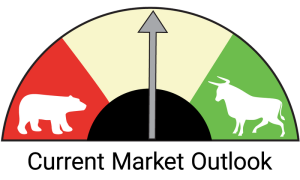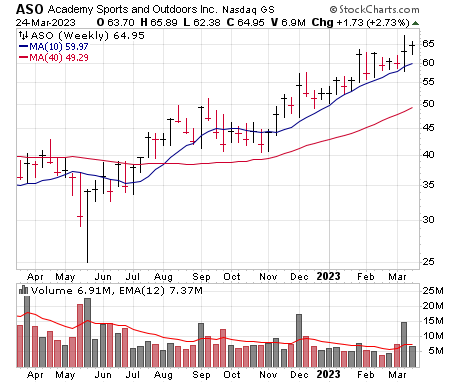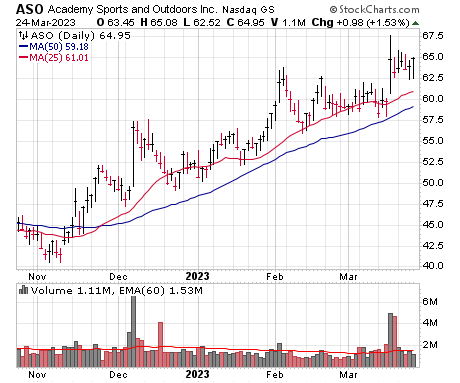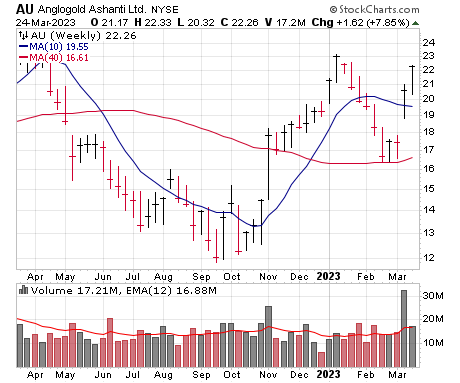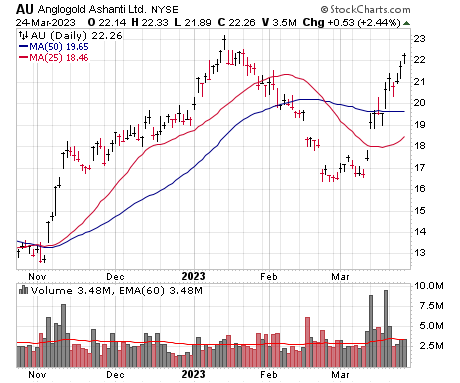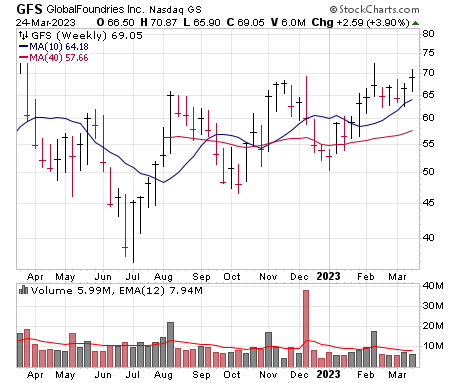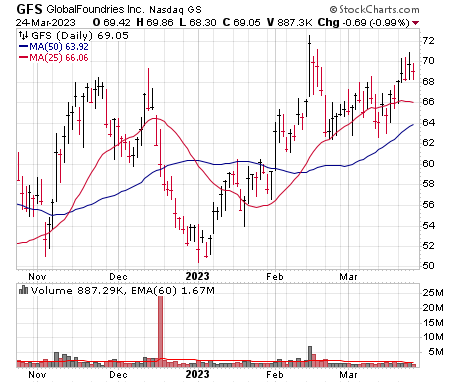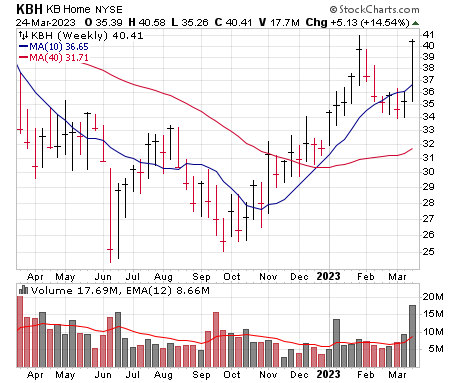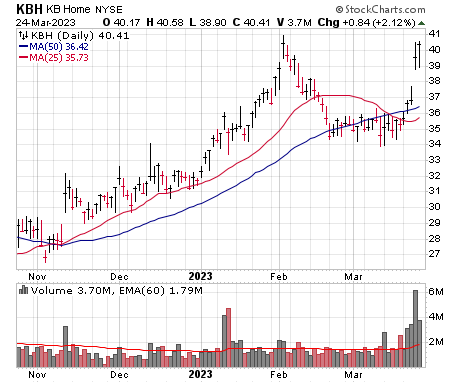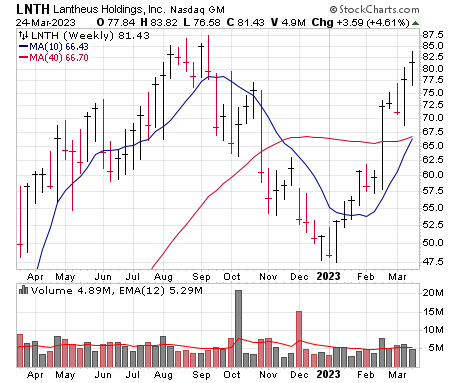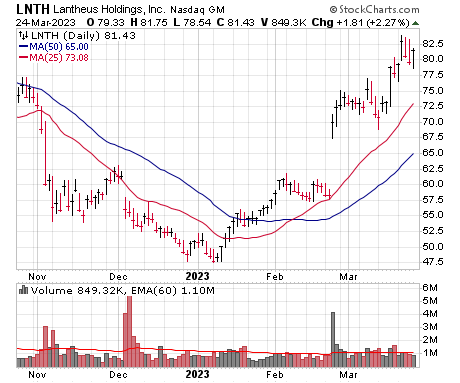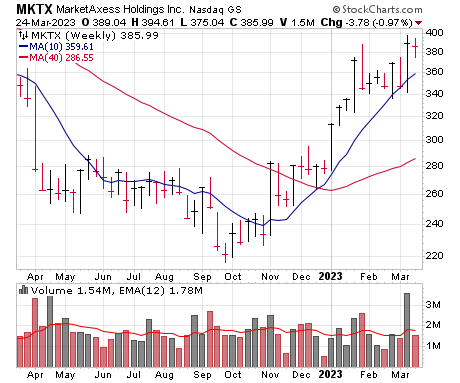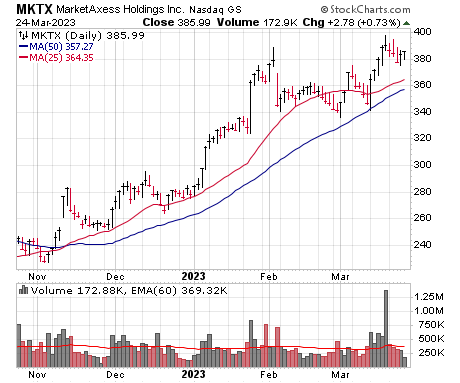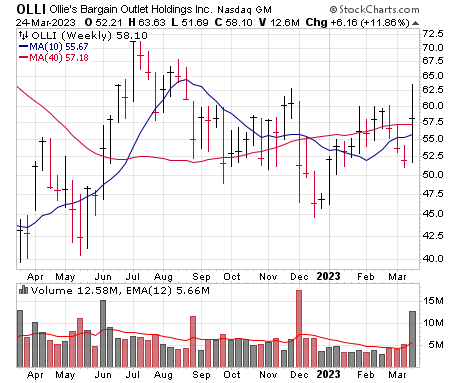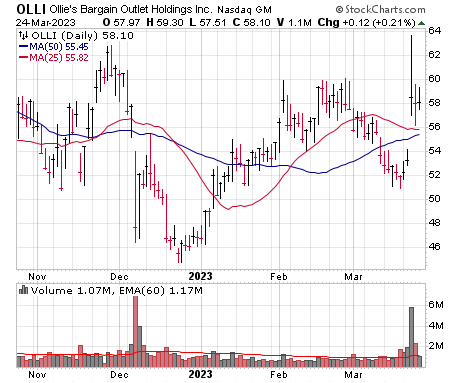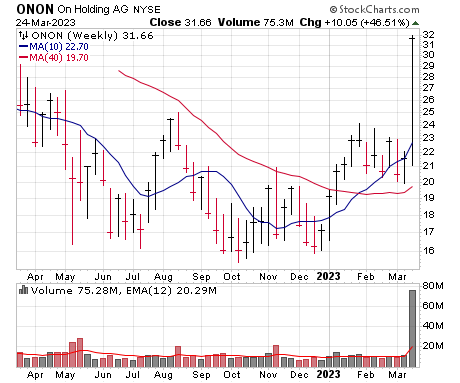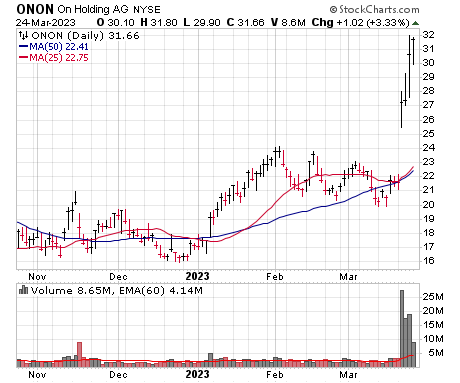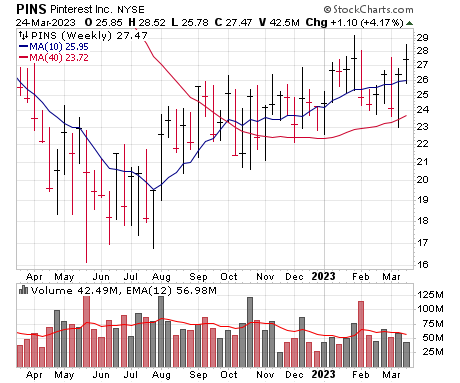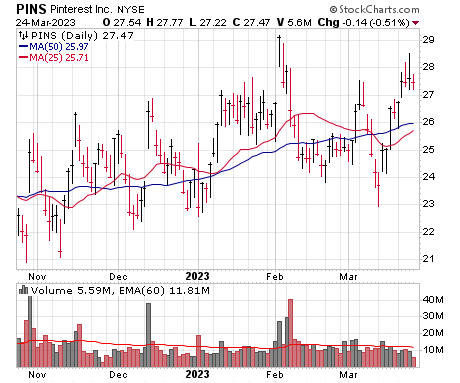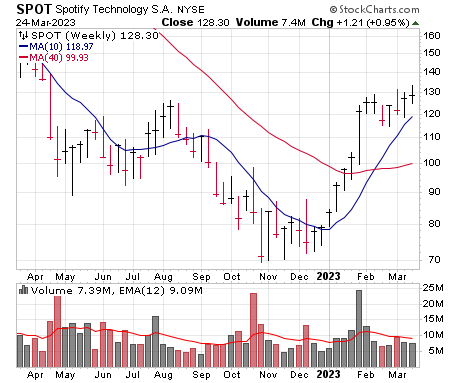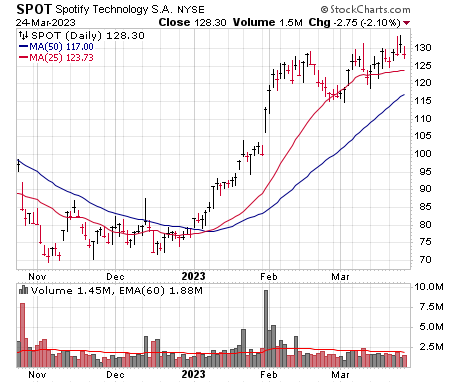Hanging in There
The market held its own last week and we’re now even seeing the worst areas out there bounce as a bit of stability shows up in the banking sector. That said, on the charts, not much has changed—some growth stocks are acting resiliently (we’re even seeing some new leadership show up), but the broad market is still buried, with the vast majority of stocks (as well as small- and mid-cap indexes) clearly below their 50-day lines. Don’t get us wrong, there’s a ton of pessimism out there, so we’re open to anything, including the scenario where an easier Fed combined with limited bank reverberations leads to a sustained advance. Right now, most of the market is hanging in there, but we need to see continued buying before changing our stance. We’ll leave our Market Monitor at a level 5 today.
This week’s list is a bit broader with some turnaround situations out there. Out Top Pick is Pinterest (PINS), which was crushed during the bear market but has bottomed out for months and now looks ready to run. Try to buy on dips.
| Academy Sports (ASO) |
| Anglogold (AU) |
| GlobalFoundries (GFS) |
| KB Home (KBH) |
| Lantheus (LNTH) |
| MarketAxess (MKTX) |
| Ollie’s Bargain Outlet (OLLI) |
| On Holding (ONON) |
| Pinterest (PINS) ★ Top Pick ★ |
| Spotify (SPOT) |
Stock 1
Academy Sports (ASO)
Price | Buy Range | Loss Limit |
Why the Strength
Academy Sports & Outdoors skirts the line between growth and value—it’s a sports goods and outdoor recreation retailer with around 270 locations and a well-balanced set of offerings that are split nearly evenly between women’s and men’s, between product categories and between the four seasons. It also plays more on the lower-priced side of the equation (20% of products are private label), which could be a plus should the economy take a hit, and it sports best-in-class sales metrics, too. The value part of the story is that the firm saw earnings go up huge during the pandemic as demand for outdoor (away from everyone else) stuff boomed, but instead of fading back, earnings have held firm, as margins have mostly held up and the top brass bought back a good number of shares (valuation here is just 8x earnings). That’s fine and would probably help the stock head up, but the kicker is the growth angle—as opposed to seeing earnings just stay level, the bottom line should rise going forward as the firm has started a new store expansion plan: It didn’t open any new locations in 2020 and 2021 (using the huge cash flow to pay off debt and buy back shares), but last year, it opened nine new locations, with another 14 on tap for 2023 (about 5% growth in the store count this year), which is the front-end of what Academy expects will be 80 to 100 new openings through 2026 (about a 30% total expansion). Q4 results were solid, with earnings easily trouncing estimates ($2.04 per share beat by 22 cents) and bolstering confidence that earnings have a high floor and, as new stores open, will eventually have another leg up.
Technical Analysis
ASO has been showing relative strength for months and lifted to new all-time highs in December after earnings. The progress since has been choppy—this isn’t a go-go stock, and of course the market has been iffy, too—but ASO has held its 10-week line as it’s crawled higher, with very little selling along the way. We think small positions are OK here or (preferably) on modest weakness.
| Market Cap | $5.05B | EPS $ Annual (Jan) | ||
| Forward P/E | 8 | FY 2022 | 7.60 | |
| Current P/E | 8 | FY 2023 | 7.70 | |
| Annual Revenue | $6.40B | FY 2024e | 7.65 | |
| Profit Margin | 9.4% | FY 2025e | 8.28 | |
| Qtrly Rev | Qtrly Rev Growth | Qtrly EPS | Qtrly EPS Growth | |
| ($B) | (vs. yr-ago-qtr) | ($) | (vs. yr-ago-qtr) | |
| Latest qtr | 1.75 | -3% | 2.04 | 27% |
| One qtr ago | 1.49 | -6% | 1.69 | -3% |
| Two qtrs ago | 1.69 | -6% | 2.30 | -2% |
| Three qtrs ago | 1.47 | -7% | 1.69 | -11% |
Weekly Chart | Daily Chart |
Stock 2
Anglogold (AU)
Price | Buy Range | Loss Limit |
Why the Strength
Gold prices are on the move again, with safe-haven demand for the yellow metal being stirred by the threat of another banking crisis, in turn creating opportunities for established gold producers. AngloGold is the world’s fourth-largest gold miner by production and boasts a diverse, high-quality portfolio of gold, silver and copper mining operations and projects in South America, Africa and Australia. Like most of its peers, AngloGold faced significant cost pressures in 2022 (mainly from labor and energy price inflation), but still turned in better-than-expected results across most key metrics while meeting its production guidance (one of the few miners to do so) in what management called a “year of significant progress.” Full-year revenue of $4.4 billion improved 13% from a year ago, and while per-share earnings of $1.29 were 12% lower, the company reported an eye-opening increase in free cash flow generation that boomed 500% from the prior year’s total. Gold production in 2022 jumped 11% to 2.7 million ounces, thanks to higher output from a key mine in Ghana, allowing the firm to end the year at the top half of its guidance range. Reducing leverage is a major focus for AngloGold, and it delivered on that front in 2022 as net debt declined $113 million (13%), putting the balance sheet in a “solid position.” Going forward, the top brass guided for 2023 midpoint production to be 6% lower and for all-in sustaining costs (AISC, a key metric) of $1,430 per ounce. But with gold prices near $2,000 an ounce—and in a position to trend higher—the company is in good shape to increase AISC margins this year, and a weaker dollar should help given its mines are outside the U.S.
Technical Analysis
AU topped last March along with the gold price, hitting a high of 26 and it followed the commodity’s decline into September, falling by more than half before the trend changed. The recovery was swift thanks to a sharp rally in gold prices (helped along by a weakening U.S. dollar), with shares touching 23 by mid-January before another tough pullback. But AU found support near the 40-week line and has popped nicely the past two weeks. We’re OK using dips to nibble.
| Market Cap | $9.35B | EPS $ Annual (Dec) | ||
| Forward P/E | 16 | FY 2021 | 1.46 | |
| Current P/E | 17 | FY 2022 | 1.29 | |
| Annual Revenue | $4.50B | FY 2023e | 1.40 | |
| Profit Margin | 10.4% | FY 2024e | 1.81 | |
| Qtrly Rev | Qtrly Rev Growth | Qtrly EPS | Qtrly EPS Growth | |
| ($B) | (vs. yr-ago-qtr) | ($) | (vs. yr-ago-qtr) | |
| Latest qtr | 1.17 | 14% | 0.29 | -2% |
| One qtr ago | 1.17 | 14% | 0.29 | -2% |
| Two qtrs ago | 1.08 | 10% | 0.35 | -17% |
| Three qtrs ago | 1.08 | 10% | 0.35 | -17% |
Weekly Chart | Daily Chart |
Stock 3
GlobalFoundries (GFS)
Price | Buy Range | Loss Limit |
Why the Strength
Automakers used to be a slow-growing market for semiconductors, but in the past three years the broad shift to EVs and the addition of many advanced driver assistance systems (such as lane assist and blind spot monitoring) into both EVs and conventional vehicles means the auto sector has become a massive growth industry for chip providers like GlobalFoundries. One of the world’s largest foundries making semiconductors and integrated circuits, GlobalFoundries sold less than $100 million of chips to car makers in 2020 but it should get close to $1 billion this year with more growth coming in the years ahead. One unique aspect to the company is that it inks many long-term agreements in concert with the expansions of its facilities (i.e., not much speculative expansion); for instance, it signed long-term supply agreements with Ford and GM last year that locked in $5 billion in future sales. It’s not just EVs and autos that are driving growth: There is also the Internet of Things and the need for chips to power 5G mobile phone capabilities. IoT grew more than 30% last year for GlobalFoundries, while 5G-related demand is growing 25% compared to single digits for the overall handset sector. Putting it all together, these tailwinds should double semiconductor demand in the next decade. The business is executing well, with 2022 revenue rising 23% to $8.1 billion, producing $3.11 in net income per share compared to a loss in 2021. Right now, there are some economic headwinds, which means sales may dip 5% this quarter. But cost efficiencies have operating margins larger than a year ago, which bodes well for future profitability growth. California-based GlobalFoundries has operations worldwide, with Singapore and Germany providing 65% of capacity. Management says its main U.S. foundry, in New York, is becoming more important, as federal programs to stimulate semiconductor manufacturing will help supply demand. After an adjustment this year, earnings should kite higher in 2024 and beyond.
Technical Analysis
GFS IPO’d in October 2021 at 47, topped out near 80 last March and bottomed below 40 in July. GFS recovered mid-summer and traded within a broad range mostly in the 47 to 67 area with slightly higher highs and lows. Q4 earnings in February brought a nice pop, and now GFS has traded calmly for a few weeks—possibly putting the finishing touches on its year-long base. You could start small here and possibly add shares on a decisive lift above 73.
| Market Cap | $37.5B | EPS $ Annual (Sep) | ||
| Forward P/E | 29 | FY 2021 | -0.05 | |
| Current P/E | 22 | FY 2022 | 3.11 | |
| Annual Revenue | $8.10B | FY 2023e | 2.38 | |
| Profit Margin | 38.1% | FY 2024e | 3.28 | |
| Qtrly Rev | Qtrly Rev Growth | Qtrly EPS | Qtrly EPS Growth | |
| ($B) | (vs. yr-ago-qtr) | ($) | (vs. yr-ago-qtr) | |
| Latest qtr | 2.10 | 14% | 1.44 | 700% |
| One qtr ago | 2.07 | 22% | 0.67 | 999% |
| Two qtrs ago | 1.99 | 23% | 0.58 | N/A |
| Three qtrs ago | 1.94 | 37% | 0.42 | N/A |
Weekly Chart | Daily Chart |
Stock 4
KB Home (KBH)
Price | Buy Range | Loss Limit |
Why the Strength
If you’ve read our writeups on housing-related names in recent weeks and months, you could probably fill in the following paragraph on your own. KB Home is a mid-sized regional homebuilder whose stock topped last year when investors saw the writing on the wall as Fed started going bananas in its tightening ways. However, despite the fears, business stayed strong for much longer than expected, and the much-anticipated downturn in earnings (which is just beginning) looks to be tamer than normal … especially with the market expecting the Fed to reverse course in the weeks/months ahead. In KB’s case, the just-reported quarterly report easily topped expectations (deliveries down a mere 3%; earnings of $1.45 per share topped estimates by 38 cents), though the under-the-surface details were uglier (new orders were down by about half compared to a year ago while backlog value was down 42%). That obviously means business will continue to slow going ahead, but even so, Wall Street sees earnings of $5.21 per share this year, which is nearly twice the peak level seen in the pre-pandemic upcycle! Of course, the risk here is that the banking crisis, while lowering mortgage rates, will send the economy into some sort of tailspin (or maybe a regional tailspin if a few banks in certain areas go under; KB does do a good amount of business in California, for instance) which would obviously crimp demand, but it’s far more likely the market looks ahead to the next housing upturn following what is shaping up to be a relatively mild down period. KB Home’s not changing the world, of course, but it’s trading at a tame valuation even at what looks like bottom-of-the-cycle earnings estimates.
Technical Analysis
KB actually topped in the spring of 2021, hit a double top near the end of that year and then was cut in half into its June 2022 low. The higher low in September set the stage for the persistent advance back into the low 40s, followed by a reasonable six-week rest period that included some tight trading (a good sign). And now we see two straight weeks of above-average buying, especially after last week’s Q1 report. We’ll set our buy range down a smidge from here.
| Market Cap | $3.39B | EPS $ Annual (Nov) | ||
| Forward P/E | 8 | FY 2021 | 6.01 | |
| Current P/E | 4 | FY 2022 | 9.09 | |
| Annual Revenue | $6.88B | FY 2023e | 5.21 | |
| Profit Margin | 9.1% | FY 2024e | 5.80 | |
| Qtrly Rev | Qtrly Rev Growth | Qtrly EPS | Qtrly EPS Growth | |
| ($B) | (vs. yr-ago-qtr) | ($) | (vs. yr-ago-qtr) | |
| Latest qtr | 1.38 | -1% | 1.45 | -1% |
| One qtr ago | 1.94 | 16% | 2.47 | 29% |
| Two qtrs ago | 1.84 | 26% | 2.86 | 79% |
| Three qtrs ago | 1.72 | 19% | 2.32 | 55% |
Weekly Chart | Daily Chart |
Stock 5
Lantheus (LNTH)
Price | Buy Range | Loss Limit |
Why the Strength
Lantheus is a leading provider of two products that helps doctors and researchers identify internal features of patients to help treat disease. Its fastest growing product is Pylarify, a diagnostic imaging agent for PET and CT scans, currently used mostly for men with potential prostate cancer that’s spread; the product was approved in mid-2021 and has been in big demand since. Combined with an AI-based software, it leads to a clearer and more detailed scan that doctors can use to better assess the situation. Lantheus generated more than 100,000 Pylarify scans in 2022, producing more than half of its total revenue of $935 million. The system is now used in every academic hospital in the U.S. and is accessible to 90% of patients who have insurance coverage for it. Management is focusing on getting more of those potential customers to use Pylarify, estimating the total addressable market is $1.6 billion annually. Lantheus also dominates in an ultrasound enhancing agent for echocardiograms, called Definity. It generated $245 million in revenue last year, its 22nd on the market, and now commands 80% market share. Even after a step-function increase in business last year, current year sales are seen growing about 24% to $1.15 billion mainly from growth in both Lantheus’ core product offerings as earnings rise 18%. Longer-term growth should come from a series of other diagnostic products that could piggyback on the success of the main offerings: There are 13 treatments in clinical trials, including expanding Pylarify and Definity’s applications. The former is close to approval for prostate cancer in Europe while Definity is in Phase III trials for use in pediatric echocardiography. The reasonable valuation (19x earnings) is also a plus.
Technical Analysis
LTHM broke through a long-term ceiling a year ago and rallied to an all-time high of 87 in August before a fourth-quarter slump cracked the uptrend—the stock fell by nearly half as investors thought the growth story had played out. But earnings have continued to top estimates, and the buyers are stepping back in—LNTH rallied nicely to start the year, then gapped on earnings and has continued higher despite the market’s wobbles. Given that shares are back into some resistance, we’d aim for pullbacks if you want in.
| Market Cap | $5.47B | EPS $ Annual (Dec) | ||
| Forward P/E | 16 | FY 2021 | 0.49 | |
| Current P/E | 19 | FY 2022 | 4.22 | |
| Annual Revenue | $935M | FY 2023e | 4.99 | |
| Profit Margin | 36.7% | FY 2024e | 5.55 | |
| Qtrly Rev | Qtrly Rev Growth | Qtrly EPS | Qtrly EPS Growth | |
| ($M) | (vs. yr-ago-qtr) | ($) | (vs. yr-ago-qtr) | |
| Latest qtr | 263 | 103% | 1.37 | 448% |
| One qtr ago | 239 | 134% | 0.99 | 999% |
| Two qtrs ago | 224 | 121% | 0.89 | 709% |
| Three qtrs ago | 209 | 126% | 0.97 | 999% |
Weekly Chart | Daily Chart |
Stock 6
MarketAxess (MKTX)
Price | Buy Range | Loss Limit |
Why the Strength
MarketAxess operates the world’s largest electronic fixed-income trading platform. It also has the broadest liquidity pool available in the global bond market, including an extensive dealer network and over 2,000 active client firms that can trade with each other. Most of the company’s money is made through trading commissions, and revenue growth is driven by both its increasing market share (as more bond trading is done electronically) and by periods of high bond market volatility (like we’ve seen in recent months). Rising interest rates and above-normal volatility in credit spreads (the difference between corporate and Treasury bond yields) account for some of the stock’s strength, but record growth in credit average daily volume (ADV, the key metric) is the main reason for it as fixed income has been moving more wildly in recent quarters, and that trend is accelerating. ADV increased 24% from a year ago in Q4, but in February alone that metric hit a record of over $14 billion, driven by 30% growth in high-grade bond trading and 43% growth in high-yield. In the wake of those impressive numbers, a major Wall Street firm upped its estimates and said the firm has reached a “positive inflection point for growth,” with stronger industry volume growth (as volatility and corporate default rates rise) and higher adoption of MarketAxess’ Open Trading protocol serving as the likely catalysts. Management also sees growth opportunities being enhanced by current bond market conditions, with the company’s Auto-X automatic execution tool expected to see increasing adoption by clients. Analysts see roughly 15% top- and bottom-line growth this year and next, which could prove conservative if credit spreads widen as economic worries mount.
Technical Analysis
MKTX peaked around 600 in late 2020, then embarked on long and relatively steady decline, thanks in part to a post-pandemic decline in credit spread volatility. Shares hit rock bottom at 220 in late September, and interestingly, there wasn’t much of a bottom area—MKTX changed character in November, starting with a high-volume push above the 50-day line and it’s stayed above that trend line since. More recently, shares have had a good-volume rally off that line; a little more weakness would be tempting.
| Market Cap | $14.5B | EPS $ Annual (Dec) | ||
| Forward P/E | 50 | FY 2021 | 6.77 | |
| Current P/E | 58 | FY 2022 | 6.65 | |
| Annual Revenue | $718M | FY 2023e | 7.75 | |
| Profit Margin | 33.3% | FY 2024e | 8.80 | |
| Qtrly Rev | Qtrly Rev Growth | Qtrly EPS | Qtrly EPS Growth | |
| ($M) | (vs. yr-ago-qtr) | ($) | (vs. yr-ago-qtr) | |
| Latest qtr | 178 | 8% | 1.58 | 15% |
| One qtr ago | 172 | 6% | 1.58 | 4% |
| Two qtrs ago | 182 | 3% | 1.78 | 1% |
| Three qtrs ago | 186 | -5% | 1.71 | -19% |
Weekly Chart | Daily Chart |
Stock 7
Ollie’s Bargain Outlet (OLLI)
Price | Buy Range | Loss Limit |
Why the Strength
With inflation refusing to go away as quickly as hoped, millions of Americans are on the lookout for ways to make their wallets stretch, providing a big opportunity for discount merchants. Ollie’s is the nation’s largest retailer of closeout merchandise and excess inventory, including food, housewares, pet supplies, toys and much more, offering discounts of up to 70% compared to regular retailers. The firm had a hard couple of years (cost pressures, sudden death of its CEO, inventory issues), but the stock is slowly gathering strength as things are getting back on track. A solid Q4 earnings report last week was a catalyst, as revenue of $550 million increased 10% from a year ago and comparable store sales improved 3% (up huge from the year-ago’s 11% decline). Adjusted EBITDA lifted 18% and per-share earnings of 84 cents were up 22% and topped estimates by five cents. Much of the company’s solid performance was due to new store openings (there were five in Q4 and 40 in all of 2022), as opposed to same-store sales, with the store count increasing 9% to 468 locations in 29 states. The company highlighted an improvement in the company’s transaction trends and said Ollie’s is focused on offering more deals to customers, expanding operating margins and growing the store base. Management also believes the firm is positioned to thrive in the current environment, thanks to a strong deal pipeline (slowing economy often equals more closeout merchandise can be had at a good price) and growing customer demand for bargain shopping. For full-year 2023, the company guided for revenue of around $2.5 billion (up almost 11% if realized), a 2% increase in same-store sales and the opening of 45 new stores (the firm will soon have the distribution center capacity to support 700 of them). Most important, earnings are expected to boom more than 50% as the long-term growth story gets back on track.
Technical Analysis
OLLI was a laggard in 2020 and 2021 and then went over the falls in early 2022, though interestingly, it bottomed ahead of most names (back in March) just under 40. After a higher low in May and a decent summer rally, the stock faded again as the turnaround took longer than expected—but now shares may be changing character. OLLI has generally acted better since the calendar flipped, dipped modestly with the market in February and then saw some solid accumulation last week. To us, it’s a decent setup—we’ll set our buy range up from here, thinking follow-through strength after earnings would tell us the buyers are in control.
| Market Cap | $3.61B | EPS $ Annual (Jan) | ||
| Forward P/E | 23 | FY 2022 | 2.36 | |
| Current P/E | 36 | FY 2023 | 1.62 | |
| Annual Revenue | $1.83B | FY 2024e | 2.53 | |
| Profit Margin | 9.5% | FY 2025e | 2.84 | |
| Qtrly Rev | Qtrly Rev Growth | Qtrly EPS | Qtrly EPS Growth | |
| ($M) | (vs. yr-ago-qtr) | ($) | (vs. yr-ago-qtr) | |
| Latest qtr | 550 | 10% | 0.84 | 22% |
| One qtr ago | 418 | 9% | 0.37 | 9% |
| Two qtrs ago | 453 | 9% | 0.22 | -58% |
| Three qtrs ago | 407 | -10% | 0.20 | -75% |
Weekly Chart | Daily Chart |
Stock 8
On Holding (ONON)
Price | Buy Range | Loss Limit |
Why the Strength
There are never any sure things in the market, and that goes double in this uncertain environment, but On Holding certainly quacks like a new leader should the bulls reassert control. On is based in Switzerland, and it got its start by people who wanted to truly develop a better running shoe—and by most accounts, they did, with a more cushion-y bottom when landing but also offering more spring when pushing off. In recent years, they’ve branched out into more sports (including tennis, where Rodger Federer modeled a shoe he liked, as well as trail running and more) and even apparel. That’s important and got the firm off to a good start, but like Lululemon and some other outfits, On has become something of a lifestyle brand, where sort-of-athletes buy their expensive wares (usually $150 or more) simply for their comfort and style. Whatever the reason, business is extremely hot: In Q4, reported last week, local currency sales lifted 92% overall, including sales up 80%-plus in every region around the world, not to mention a 104% gain in wholesale revenue and a 76% boom in direct-to-consumer sales—all while margins held up as management said it avoided most discounting around the holidays. Guidance for 2023 (revenues up around 40%) was also better than expected, with the early 2022 supply chain issues clearly in the past, and all of that caused a frenzy of buying—interestingly, Fideltiy Contrafund owned 8.3 million shares (about 1.3% of the company) as of year-end, and clearly some big investors piled in last week. There have been many athletic footwear/athletic gear winners (Crocs, LA Gear, Reebok, Nike, Under Armour) over time, and On Holding could be the next one in line if management continues to pull the right levers.
Technical Analysis
ONON is looking pretty classic on its chart, with an IPO, a huge downtrend, and then support appearing that spring in the 16 area—and that 16 area held many times through year-end. The early 2023 rally was decent, with a choppy six-week pullback alongside the market holding above the 40-week line. Then came last week, which sent shares into orbit on four days of overwhelming buying volume. Yes, it’s extended and is sure to be crazy volatile; we’re OK starting a position here or on dips.
| Market Cap | $20.0B | EPS $ Annual (Dec) | ||
| Forward P/E | 82 | FY 2021 | 0.02 | |
| Current P/E | 106 | FY 2022 | 0.30 | |
| Annual Revenue | $1.29B | FY 2023e | 0.38 | |
| Profit Margin | 1.8% | FY 2024e | 0.59 | |
| Qtrly Rev | Qtrly Rev Growth | Qtrly EPS | Qtrly EPS Growth | |
| ($M) | (vs. yr-ago-qtr) | ($) | (vs. yr-ago-qtr) | |
| Latest qtr | 397 | 89% | 0.02 | N/A |
| One qtr ago | 332 | 42% | 0.07 | 217% |
| Two qtrs ago | 305 | 61% | 0.15 | 566% |
| Three qtrs ago | 255 | 72% | 0.05 | 146% |
Weekly Chart | Daily Chart |
Stock 9
Pinterest (PINS) ★ Top Pick ★
Price | Buy Range | Loss Limit |
Why the Strength
The cook-from-home and crafting trends established during lockdowns made social media site Pinterest a huge hit for users worldwide. As pandemic restrictions loosened, however, Pinterest lost some of its audience as total active users declined. But the site is still a popular go-to for millions of people and offers a ton of recipe ideas along with instructional videos on an unlimited range of topics, while allowing users to customize shopping for products based on tastes. Interest in the site is picking up again, with the user count growing in the last two quarters even as the company is undergoing a shift in strategy. Indeed, new management is focused on transitioning from an ad-focused revenue model toward monetizing its substantial base of monthly active users (MAUs) via more e-commerce (the new CEO is a recognized expert in this area). The growth potential is particularly huge for Pinterest’s international audience, which makes up 80% of its users but is only a fraction of total revenue (management believes 50% of the company’s sales will eventually come from overseas users once the transition is complete). The pivot toward improved monetization per user has also attracted the attention of two well-known Wall Street fund managers, both of whom recently purchased sizable stakes in the company and one of which sees “significant potential for growth.” On the financial front, Q4 revenue of $877 million increased 4% from a year ago, while EPS of 29 cents topped the consensus by a cent. Global MAUs rose 4% to over 450 million in the quarter, underscoring what Pinterest said was a “solid” year of MAU growth. Most importantly, after a rough stretch, earnings are likely to pick up steam this year and accelerate into 2024.
Technical Analysis
PINS had a fantastic run in 2020, but the stock fell apart in 2021 soon after reaching an apex of 90 in February. Shares swooned over the next 15 months, finally coming to rest above 16 last May and spending nine more weeks etching out a base. The turnaround hasn’t been dramatic yet, but it began last summer and PINS has been slowly etching higher highs and lows in recent months, with the recent test of the 40-week line leading to a quick bounce. If you want in, we’re game for a nibble on some weakness with a stop in the 25 area.
| Market Cap | $19.0B | EPS $ Annual (Dec) | ||
| Forward P/E | 36 | FY 2021 | 1.13 | |
| Current P/E | 45 | FY 2022 | 0.62 | |
| Annual Revenue | $2.80B | FY 2023e | 0.77 | |
| Profit Margin | 23.2% | FY 2024e | 1.02 | |
| Qtrly Rev | Qtrly Rev Growth | Qtrly EPS | Qtrly EPS Growth | |
| ($M) | (vs. yr-ago-qtr) | ($) | (vs. yr-ago-qtr) | |
| Latest qtr | 877 | 4% | 0.29 | -41% |
| One qtr ago | 685 | 8% | 0.11 | -61% |
| Two qtrs ago | 666 | 9% | 0.11 | -56% |
| Three qtrs ago | 575 | 18% | 0.10 | -9% |
Weekly Chart | Daily Chart |
Stock 10
Spotify (SPOT)
Price | Buy Range | Loss Limit |
Why the Strength
Spotify is known for its music offerings and has long had a leading global position in music streaming subscriptions. But the company is now looking to broaden its platform to include more podcasts and audiobook offerings, while increasing advertising and upping its use of artificial intelligence. Collectively, these efforts are already paying off, as Spotify added over 80 million listeners last year, a 20% increase from 2021. Sixty million of those listeners are categorized as “ad-supported,” which means they’re brought in by the company’s free service, with the intention of turning many into paid subscribers. This freemium strategy has paid off well for Spotify, which is turning more of its attention toward the younger generation. The pivot toward marketing the company’s services to Generation Z involves offering song-themed games on its platform, along with other popular social features. This was shown in a solid Q4 which featured strong sales growth and guidance-beating gross margins. In local currency, total and premium revenue both increased 18% from the year-ago quarter, led by subscriber gains, while ad-supported revenue grew 14%, led by podcasting. Monthly active users (MAUs, a leading indicator) increased 20% to 490 million and above guidance, while net additions of 33 million represented the company’s largest ever Q4 growth. The sanguine results elicited a bullish response from Wall Street, with an activist investment firm taking a stake in Spotify with an aim to cut costs and improve operating efficiency for the streaming service. Management, meanwhile, guided for total premium subscribers to rise 1%, total MAUs to increase 2% and for revenue to grow 10% in Q1.
Technical Analysis
After a rough 2022, SPOT turned the corner in January, starting a rally once the calendar flipped. The stock accelerated after the solid earnings report and gained even more traction after news of the activist investor buying shares was made public. After a brief dip toward the 25-day line last month, SPOT quickly recovered and has continued to outperform the market in recent weeks. If you want in, we suggest aiming for dips.
| Market Cap | $24.8B | EPS $ Annual (Dec) | ||
| Forward P/E | N/A | FY 2021 | -0.20 | |
| Current P/E | N/A | FY 2022 | -2.39 | |
| Annual Revenue | $12.3B | FY 2023e | -1.91 | |
| Profit Margin | N/A | FY 2024e | 0.01 | |
| Qtrly Rev | Qtrly Rev Growth | Qtrly EPS | Qtrly EPS Growth | |
| ($B) | (vs. yr-ago-qtr) | ($) | (vs. yr-ago-qtr) | |
| Latest qtr | 3.39 | 11% | -1.50 | N/A |
| One qtr ago | 2.98 | 3% | -0.84 | N/A |
| Two qtrs ago | 3.00 | 9% | -0.68 | N/A |
| Three qtrs ago | 2.94 | 17% | 0.75 | N/A |
Weekly Chart | Daily Chart |
Previously Recommended Stocks
| Date | Stock | Symbol | Top Pick | Original Buy Range | 3/27/23 |
| HOLD | |||||
| 9/12/22 | ★ | 48.5-51.5 | 64 | ||
| 3/20/23 | Avanced Micro Devices | AMD | 91-94 | 97 | |
| 3/6/23 | 23-24 | 29 | |||
| 2/13/23 | ★ | 40.5-42.5 | 46 | ||
| 2/27/23 | 38-40 | 38 | |||
| 2/27/23 | ★ | 116-122 | 129 | ||
| 3/6/23 | ★ | 215-222 | 218 | ||
| 2/27/23 | 99-103 | 106 | |||
| 3/13/23 | 141-144 | 135 | |||
| 3/13/23 | 17.3-18.0 | 18 | |||
| 3/6/23 | 115-121 | 137 | |||
| 2/27/23 | 159-163 | 159 | |||
| 3/6/23 | 202-208 | 210 | |||
| 11/7/22 | 145-150 | 199 | |||
| 3/20/23 | Floor & Décor | FND | 95-97 | 92 | |
| 3/20/23 | Fortinet | FTNT | ★ | 59.5-61.5 | 64 |
| 3/13/23 | 14.8-15.2 | 17 | |||
| 3/20/23 | HubSpot | HUBS | 378-388 | 400 | |
| 3/20/23 | Lennar | LEN | 105-107 | 102 | |
| 3/6/23 | 53-55 | 56 | |||
| 2/27/23 | 225-230 | 265 | |||
| 3/20/23 | PagerDuty | PD | 29.5-31 | 32 | |
| 2/27/23 | 180-185 | 193 | |||
| 1/9/23 | ★ | 218-226 | 278 | ||
| 2/6/23 | 54.5-56.5 | 57 | |||
| 3/13/23 | ★ | 18-19 | 19 | ||
| 11/21/22 | 44-46 | 67 | |||
| 2/27/23 | 94-97 | 111 | |||
| 3/13/23 | 725-735 | 714 | |||
| 3/20/23 | Wheaton Prec Metals | WPM | 44-45 | 47 | |
| 8/22/22 | 115-120 | 182 | |||
| 3/13/23 | 650-665 | 671 | |||
| 12/5/22 | Wynn Resorts | WYNN | 81-84 | 106 | |
| WAIT | |||||
| 3/20/23 | 14.4-14.9 | 16 | |||
| 3/20/23 | Smartsheet | SMAR | 44-45.5 | 47 | |
| SELL RECOMMENDATIONS | |||||
| 2/21/23 | Hexcel | HXL | 68.5-71 | 68 | |
| DROPPED | |||||
| 3/13/23 | 144-148 | 168 | |||
| 3/13/23 | 177-182 | 203 | |||
The next Cabot Top Ten Trader issue will be published on April 3, 2023.
